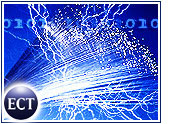
Stanford University researchers claimed a major step toward optical computing, which speeds data delivery — by using light instead of electricity — through materials already common in the semiconductor industry.
The research, detailed in the latest version of the science journal Nature, involved the use of germanium to create a light switch that the researchers said may serve as the basis of optoelectric circuits and switches utilized in light-based or so-called optical computing.
The Stanford researchers claim the optoelectric component they have created may be able to operate as much as 50 times faster than today’s electrical computing and do so with materials, often used in today’s silicon semiconductor manufacturing, that have previously been limited when it comes to conducting and controlling light.
Standard Stuff
The Stanford researchers stressed that while other optoelectrical solutions are typically reliant on rare or exotic materials, their modulator was made of the germanium and silicon materials that are commonly used in today’s chip manufacturing.
The use of silicon was also helpful in that it would allow a single, consistent platform on which to build optoelectrical components and systems, which will speed computing with the use of laser light.
Some other efforts in the area of optoelectronics and quantum computing, such as HP’s platinum and titanium “crossbar latch” announced earlier this year, rely on non-silicon materials.
Silicon Steps
However, industry analysts such as Gartner research Vice President Martin Reynolds have indicated that there is still plenty of life in silicon and related materials, which continue to be stretched by research and development efforts such as Stanford’s.
“Silicon is a fantastic vehicle for making tiny stuff,” Reynolds told TechNewsWorld. “We have seen it extended to mechanical components, like [Texas Instruments’] DLP [digital light processing] devices. There will be chemical, biological, optical and ultimately quantum devices built on the back of silicon process technology.”
Reynolds said while much of the work toward optoelectric and quantum computing has more relevance for communications, steps are being made toward creating the important components of emitters, detectors and modulators.
Outside the Box
Mercury Research President Dean McCarron pointed out that the optical computing advances may be tempered by the fact that computers are merely parts of larger systems.
McCarron told TechNewsWorld that, regardless of the technologies that they rely on, computers must still interact with existing electrical infrastructure and electronics.
“It’s one thing to have a computing core based on newer technology, but to get information in and out, you’re going to be relying on today’s technology,” McCarron said.
Charging Ahead on Chips
Intel Research spokesperson Kevin Teixeira — whose company helped fund the Stanford research along with U.S. Defense Advanced Research Projects Agency — told TechNewsWorld that such research is contributing to the achievement of real-world optical computing.
Referring to Intel’s efforts to bring photonics capabilities to silicon, Teixeira said the challenges lie in building up the silicon-based components without too much signal loss.
Teixeira also stressed Intel’s work in extending the life of silicon, which is more feasible for real world application.
“Using exotic compounds and such — you’re not talking mass volume,” he said. “A few in the lab is not like creating billions.”





















































